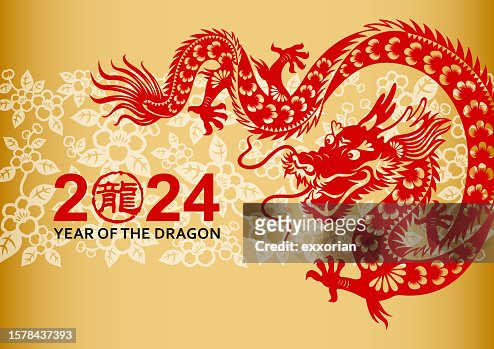And 2024 belongs to the Year of the Dragon which is believed to embody power, strength, luck, and wisdom. Many traditions are tied to the festival as some South-East Asian and East Asian countries and their diaspora communities observe this auspicious time — in ways that are unique to each culture.
The Year of the Rabbit ended February 9, 2024. And then the Year of the Dragon started February 10, 2024. Next comes the year of the Green Wood Snake, starting on January 29, 2025.
As you already know, In China, and other Asian countries, the familiar Gregorian calendar is used for day-to-day life. But Chinese calendar dates continue to be used to mark traditional holidays such as the new year and the fall moon festival. And then Chinese astrology uses the lunar calendar to determine favorable dates for weddings and other special events.
In other words, the Chinese calendar is a lunisolar calendar, a combination of solar and lunar calendars. Plus, it has a long history spanning several Chinese dynastic periods from as far back as the Shang Dynasty around the 14th century BCE. Also, there are several different symbolic cycles within the calendar, used in Chinese astrology.
So the Chinese calendar is an intricate and complex measure of time.
One of 12 animal symbols of the Chinese zodiac (Rat, Ox, Tiger, Rabbit, Dragon, Snake, Horse, Sheep/Goat, Monkey, Rooster, Dog and Boar/Pig) represent each year of the Chinese lunar calendar. For 2024, it’s the Year of the Dragon. TravelChinaGuide.com says:
- Year of the Dragon
Chinese Dragon is de facto an imaginary animal, also the only fictitious creature in the 12 zodiac animals, which is composed of 9 animals, including the body of a snake, the horns of a deer, the head of an ox, the mouth of a crocodile, the claws of an eagle, and the scales of a fish. The Dragon enjoys a very high reputation in Chinese culture and it represents auspiciousness and imperial power since ancient times.
Chinese people regard themselves as descendants of the Chinese dragon and emperors entitled themselves exclusively as the ‘dragon’. It is the token of authority, dignity, honor, success, luck, and capacity
- How is it celebrated?
From the first day of the Lunar New Year (the day of the new moon) to the 15th day (next full moon), Lunar New Year celebrations abound. What’s more, each day holds a special significance that varies according to local traditions. But first, before the arrival of the new year, homes are thoroughly cleaned to sweep away ill fortune and to welcome good luck. Then on New Year’s Eve, families traditionally gather to celebrate and enjoy sumptuous traditional feasts. Finally, at midnight, they greet the new year with fireworks.
In the days that follow, celebrations include a variety of festivities. For example, there are dance parades featuring colorful dragons or lions. Or there are ceremonies to pay homage to deities and ancestors. Plus, children receive money in red envelopes and gifts are exchanged. Extended family members travel long distances to visit each other.
The Lunar New Year celebration traditionally culminates on the 15th day with the Lantern Festival. On this night of the full moon, families mingle in the streets carrying lighted lanterns, often creating a beautiful light display.
- Mythology & Lunar Year :
There are several variations on the mythology behind Lunar New Year celebrations. Most concern the story of an ugly, bloodthirsty monster named Nian. The monster would emerge on the last night of each year to destroy villages and eat people. A wise elder advised villagers to scare the monster away with loud noises. That night, they set fire to bamboo, lit fireworks, and banged their drums. So the monster, afraid of the loud noises and lights, ran away to hide in its cave.
In another version of the myth, an old man persuaded Nian to turn its wrath on other monsters, not the villagers. Before he was seen riding away on Nian, the old man, actually a god, advised the people to hang red paper decorations in their homes and set off firecrackers on the last night of the year to keep Nian away.
Then on the first day of the new year, the villagers celebrated, greeting each other with the words Guo Nian, which mean “survive the Nian.” That tradition has continued to this day, with Guo Nian now meaning “celebrate the new year.”
via EarthSky
Education :
“The 2 Chinese characters are the same. It means blessing, a hope that other people will get good luck. Blessings like these are commonly used during Lunar New Year. The red background is also a kind of good as Chinese people use red to represent good luck."
graphic meaning
As you see interculturality is so important. Three-quarters of the world’s major conflicts have a cultural dimension.
- To raise awareness worldwide about the importance of intercultural dialogue, diversity and inclusion.
- To build a world community of individuals committed to support diversity with real and every day-life gestures.
- Perhaps you have Asian students in your classroom. Invite them to share their own family traditions to celebrate the New Lunar Year.
Learners are curious about other cultures and traditions. Let students participate in different activities by doing ONE thing for diversity.
- Values: family, friends, honoring old people. And of course, sensitivity, prosperity and peace.



No comments:
Post a Comment